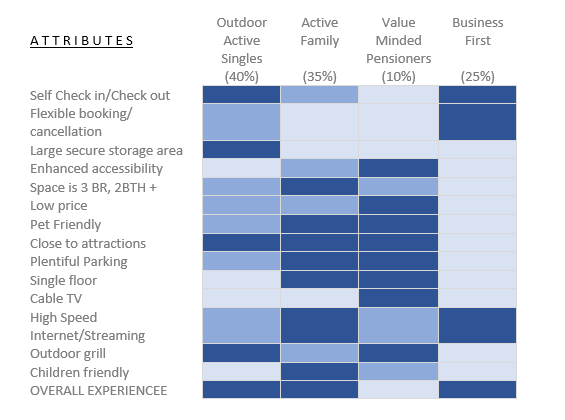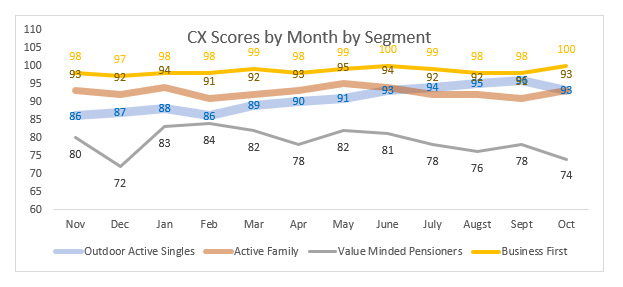“A FOUR, A F*CKING FOUR!???” I yelled at my smart phone.
I stared at the number in disbelief.
I looked at my wife who shrugged.
It was our first non-perfect score (4 out of 5) at our Airbnb and I was incensed. It got worse on the other ratings but thank god that only the overall was publicly displayed.
I took a breath and started reading. It had complaints about no live TV (we use only streaming in our Airbnb), the couch was uncomfortable, a lack of ‘grab bars’ in the shower, and ‘pricey’. I took a breath and then looked at the picture of our guest and then it struck me.
This isn’t our usual customer.
Our customers tend to be 30-50 somethings who are traveling to Northwest Arkansas to mountain bike or for business meetings. They tend to be affluent, active, and tech-savvy. Their priorities are ease of check in and check out, quiet, good parking, distance to city center and Northwest Arkansas’s trail system. We’ve had close to 100 guests so far and only perfect scores.
This customer who dared to give us a 4 out of 5 was 60 something older women from a neighboring town in Arkansas. She doesn’t watch Hulu, doesn’t mountain bike, and is apparently not too steady on her feet. What she does want is a comfortable couch, a low price, and the ability to watch American Ninja Warrior on live TV.
It was a mismatch thus our ‘low’ score.
This happens all the time. This is also why many syndicated studies that publish ‘lists’ are of limited value. If you served a meat lovers pizza to a vegan, of course you are going to get low marks. Young people want different things than older people. Families have different needs than singles. Mountain bikers want different amenities than pinocle players.
The Danger of Hiding Behind Averages
An old market research research joke goes… “on average, humans have one breast and one testicle”
This of course is true in the aggregate, but I wouldn’t call it an accurate depiction of human beings. To understand customers, we can’t view them a uni-dimensional, we have to understand individual differences and provide services accordingly. We also need to measure the experience in this way.
Unfortunately, the CX world has largely ignored this and favor of monolithic NPS and other “indices”. Using indices to mindlessly benchmark yourself to others is misguided. My favorite example of this come from the intrepid mystery shoppers at Pied Piper with their ‘Prospect Satisfaction Index’. In this study of auto dealers, they found that Tesla ranked dead that purported to report on which brands were ‘most helpful’ in shopping to customers.
Here’s the problem, most dealerships jump on customers like they are the last slice of pizza after a Phish concert. This PSI index measures such things such as if the sale person asked about the customer about visiting the dealer website or if the salesperson had to get ‘best price’ from management. Things that can frankly annoy some customers but can help sell cars. But…that’s not Tesla’s model. They simply let the customer shop and answer questions if they have any.
Tesla took the news of their last-place position in stride….

Segmenting Your Customers
So how do you go about parsing your customers (and non-customers) into categories. What the CX world needs to adopt is a technique used in traditional marketing research since the 1950s: Market Segmentation. Let’s do a quote shall we?
“Market Segmentation involves viewing a heterogeneous market as a number of smaller homogeneous markets, in response to differing preferences, attributable to the desires of consumers for more precise satisfaction of their varying wants” (Smith, 1956)
I think we can all agree if we could customize an experience on an individual level that would be ideal, but it is usually not practical, so we split the difference and focus on (fairly) homogeneous groups. We can then adjust both the experience for each group accordingly. Here’s how you do it.
Step 1: Understand Your Customers
Let’s pretend that instead of two houses, the Trailhouse brand (our Airbnb) had 100 locations. Let’s also say we regularly collected customer experience data. We first might conduct a brief study among past guests and find out a few things; why did they visit, what things are important to them about staying in an Airbnb for that stay, and how was their experience, and some profiling variables (age, gender, family etc.).
If you owned your own booking platform (we don’t) you could capture the reason for the trip at the time of booking. You could capture their overall experience upon check out. This leaves you to gather up things important to them about their stay either at check out or at a later time. Many booking platforms require a ‘profile’ which is another place to gather up this one-time information. With this data in hand, you can move on to segmenting your customers.
Step 2: Segment Your Customers
There are many methods to segment your customers. Segmentation masters Michel Wedel and Wagner Kamakura provide a great framework in their aptly entitled book “Market Segmentation”. In segmentation, you have two things to consider; your ‘base’ or what you going to segment on, and how you plan to classify folks. Your base choices vary on observable/no observable and general vs. specific.

In our case we would probably want to focus on “unobservable” and “specific”; aspects of their stay that are important to them. We would also want to pick some profiling variables that could be used as surrogates for our base. That way we don’t haves to re-ask questions on an on-going basis.
As far as classification approach we have a variety of methods to choose from based on the nature of the data and the technique. In our example we would probably want to understand what is driving certain customers to like or dislike the Trailhouse experience. To predict drivers and cluster groups simultaneously we would use Clusterwise Regression or Latent Class Analysis.
Here’s what the output might look like.

In the rows have the attributes and, in the columns, we have data-derived clusters. First, we see are largest segment are “Outdoor Actives” followed by “Active Family”. We also have some business users, and finally Value Minded Pensioners. The clusters were derived from the data (the base variables).
We can see they have very different priorities and preferences with the darker shades of blue being more important and lighter shades less important. For example, business traveler strongly values flexible booking and cancelations while young families need more space. We can also see most folks like the Trailhouse with some weakness amongst Value Minder Pensioners.
Step 3: Apply the Algorithm to Your CX Tracker
Where possible, I advocate very short surveys, especially in transactional programs. These are the surveys you get in-app after your Uber ride or after calling the call center via SMS text. In this circumstance, we could perhaps ask two questions via text or email (or in-app if there is one).
- What was the reason for your trip? (select that all apply)
- How was your overall experience?
We might also ask if there is a need for a follow-up and comment box. We now can use the reason for their trip as a proxy (statistically derived) for their segment. This could also be achieved by asking a subset of questions and using modeling to predict their segment. Now you are not looking at all your customers the same. Your dashboard could look like this.

We can see that we rock it with business customers, but they are a smaller part of our business (25%). We don’t do too well with value-minded pensioner, but they are a smaller share of guests, and they are not on target, so we probably don’t want to be something we are not, and our best bet is to steer these folks to another property.
Step 4: Make Changes to Your Experience
This is the most important part of the process; using the data to make strategic and tactical changes and then observing what, if any impact, it had on the experience and business outcomes.
For example, if we looked at this in January, we might be concerned about our Outdoor Active Singles. Perhaps we mined the comments and found that lack of storage for bicycles was an issue in some locations and decided to install smaller bike lockers on-site in those locations.
Now we can see the result of our investment. In March things start picking up for this younger outdoor group. In this way, you could separate your target customers from your non-target and also developed segment-specific tweaks to their experience and observe it made a difference.
Making Data Work for You
I always tell my daughters to keep their eyes on their own paper when comes to grades. I think the same advice is worthy to follow in CX measurement. While it is good to know where the competition is at and if possible, learn from them, ultimately you need to focus on delivering on your value proposition for your customers.
Developing and implementing a segment based CX system will help you do just that. The good news this isn’t new. Marketing and product development folks have been doing this for decades to very good results. It’s time to move away from the monolithic one score one customer mindset and look at customer differences as they relate to the experience you are delivering.



